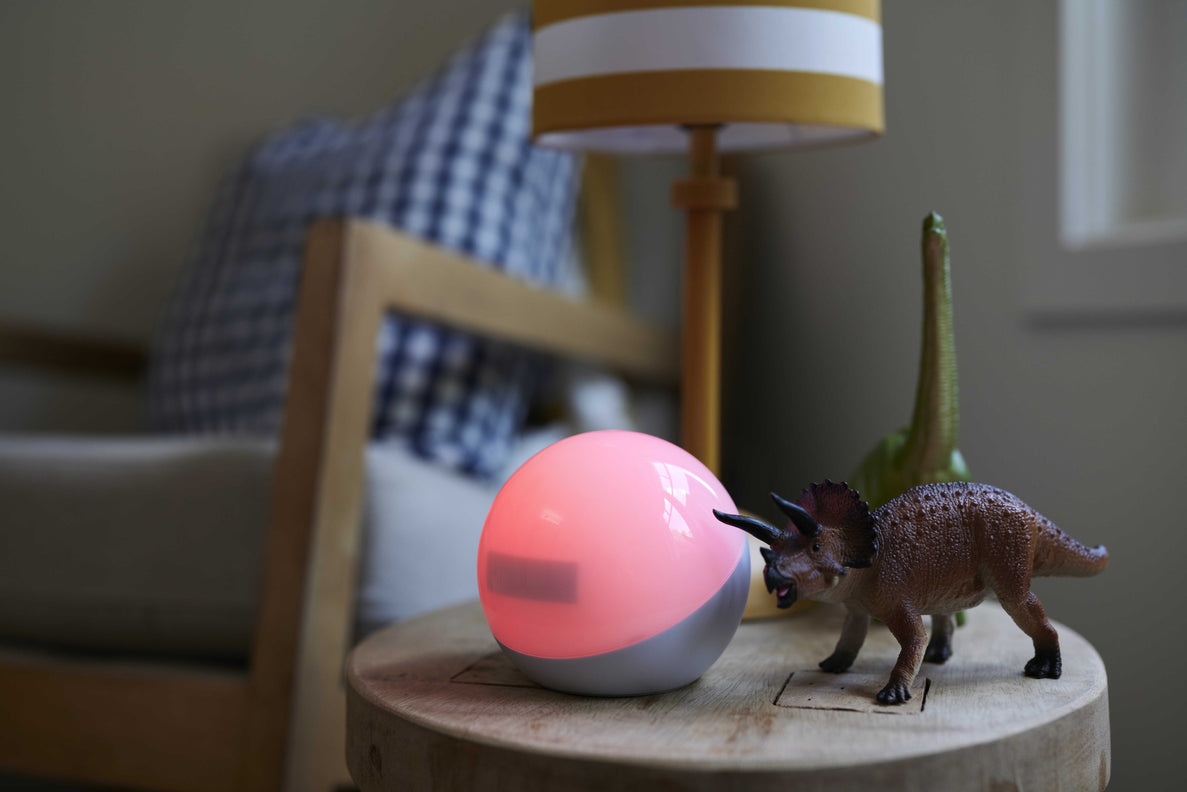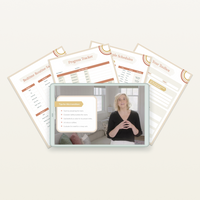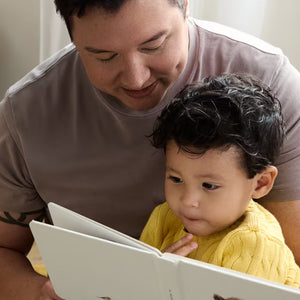Toddler parents often wonder if they can use an OK-to-wake clock in their child’s bedroom, how to use it properly, and whether it will affect their toddler’s sleep. Toddler clocks can be a useful tool. Let’s dive in!
What is an OK-to-wake clock?
An OK-to-wake clock is simply a clock that uses colors to visually cue your child’s brain that it’s time for sleep or it’s “ok to wake.” These clocks for little ones have several names: OK-to-wake clock, color-changing clock, sleep training clock, and toddler alarm clock, just to name a few. No matter the name, OK-to-wake clocks can be a helpful tool for toddler sleep.
Do OK-to-wake clocks work?
Toddler clocks are not a standalone solution for early morning wakings, night sleep struggles, or bedtime battles, but they can be helpful!
Toddlers thrive on routine and boundaries, so using an OK-to-wake clock can help in both these areas. It will act as a visual tool and reminder to communicate expectations to your toddler for when it is or isn’t time to get out of bed. This will require you to be consistent in communicating your expectations and holding firm to boundaries for your toddler. It’s also important to maintain a consistent bedtime routine to signal to your toddler that it’s time to get ready to go to bed.
What age should I introduce an OK-to-wake clock?
You can start using color-changing clocks at any age. Just know that if your little one is younger than 3 years old, your main goal is simple: We just want to start showing them that when the light turns green, we start the day. This means that before you go into their room, make sure the light is green. Having an app to control the light on your phone can be helpful for this because you can turn the light green before you walk in.
Once you are in their room, say “Look, your light is green, it’s time to start our day!” Again for these younger toddlers, you are simply trying to teach your child a pattern of cause and effect - when it’s time to get up, my light turns green.
If your little one is older than 3, knows their colors, and can communicate well, you can help them understand how the color-changing clock shows them when they are allowed to begin their day.
What color should I use for my child’s toddler clock?
Some color-changing or OK-to-wake clocks can also act as a night light. If your child doesn’t need a night light, then there is no need to use it for bedtime or during sleep; you can leave it turned "off" at night, while using for wake-up in the morning. If you do decide to use your color-changing clock as a night light, I recommend using red for nights because it is the least disruptive color for sleep.(1) If the OK-to-wake clock allows it, we want to set the light setting to its dimmest effective brightness.
For wake-up time, green is the most commonly used color. If your color-changing clock allows you to pick the color, feel free to let your little one choose a color that makes sense to them. Get your toddler involved and give them the opportunity to use their voice to make a decision in the new routine.
Expert Tip: To keep it simple, I like to use red for nights: “Red means bed,” and green for wake-up time: “Green means GO.”
How do I use an OK-to-wake clock?
Here are some of my best tips for setting up your toddler’s clock:
1. Show your toddler how the clock works.
Show your child the different colors and what they should do when the clock changes colors. Have them practice a few times so they feel comfortable with what the colors mean and understand your expectations. Make this fun! For example, pretend to sleep when the light is red, then jump out of bed to say “good morning” when the light turns green!
2. Turn the clock light to your “night” color before entering the room for bedtime.
When your toddler sees the clock light on before bedtime or during their bedtime routine, they receive a visual cue from their clock that it’s time for bed. This will help reinforce what they are hearing from you as well.
3. Set the toddler clock to turn on at a realistic time.
For most young children, a natural and biologically appropriate wake time is between 6:00 and 7:00 am. Set the clock to turn on at 6:00 am or just a bit after so your toddler knows it’s “ok to wake” if they make it to this time. If your child is waking before 6:00 am, my blog about Early Morning Wakings can help.
Now, if your little one already sleeps until 7:00 am regularly, it’s perfectly fine to set your clock to turn on at 7:00 am instead. Just know that for a child who regularly wakes at 6:00 am, a clock that doesn’t turn on until 7:00 am is likely to cause frustration for you both.
4. When your toddler follows the cues of the clock, praise them for it.
The important thing is to acknowledge and praise them for their efforts. This helps get your toddler excited about using the clock and reinforces the process.
5. Stay consistent.
Your toddler may grasp the idea of an OK-to-wake clock quickly or it may take some time. The more consistently you use the clock, the faster it will become a visual cue that it’s time to start the day.
If you need a more holistic, step-by-step plan for your toddler's sleep, check out my Toddler Sleep Training class. I'll hand you the tools you need to navigate sleep with your 2, 3, or 4-year-old so that your whole family can thrive
How long should the wake-up color stay on in the morning?
I love a wake-up range of about 30 minutes or so at this age. If your wake-up range is between 6:30 and 7:00 am, then keep the light green for just a touch longer, so it's green when you go in to wake your child if they're not awake by 7:00 am.
If it seems like the light from the clock is waking your toddler, you may want to adjust the brightness to a dimmer setting.
What are the best OK-to-wake clocks?
There are many toddler clock options out there, here are a few things to consider:
-
Bluetooth/App Control: Some OK-to-wake clocks can be programmed from your phone. This can be great when you need to adjust when it’s time to wake up without going into your little one’s room.
-
Colors: Some OK-to-wake clocks have the option to choose your own colors. If you are also using the light as a night light, having the option for a red light is the least disruptive to sleep.
-
Multiple Programs: Some clocks have the ability to schedule a light for naps and nights.
-
Child Lock: Some OK-to-wake clocks have a child lock feature so your toddler can’t change the settings. This can be helpful if you have a curious little one who likes pushing those buttons.
-
Extra features: Some OK-to-wake clocks can have additional features like sound machines, nightlights, battery operation, or a built-in clock that may be appealing.
I’ve put together a list of some of my favorites for you here.
Whichever color-changing clock you choose, we want to keep our expectations realistic for how quickly our toddlers will adjust to using the clocks. So give your little one time to practice and fully understand their OK-to-wake clock.
It’s not too late to help your toddler become a great sleeper! My Toddler Sleep Training class will teach you everything you need to know about toddlers and sleep. Let me give you step-by-step guidance through a fully-customizable approach to toddler sleep, tools to keep you emotionally connected to your child as they learn independent sleep, detailed help through toddler naps and quiet time, and so much more.








